October 2019 Independent Eating and Drinking Newsletter
| Independent Eating and Drinking are Wonderful |
 |
| October Newsletter Topics: |
|
| Subscribe to Newsletters |
Sensagent Corporation: Online Encyclopedia, Thesaurus, and Dictionary defines pulmonary aspiration as:“the entry of material (such as pharyngoeal secretions, food or drink, or stomach contents) from the oropharynx or gastrointestinal tract into the larynx (voice box) and lower respiratory tract (the portions of the respiratory system from the trachea (windpipe) to the lungs). A person may either inhale the material, or it may be delivered into the tracheobronchial tree during positive pressure ventilation. When pulmonary aspiration occurs during eating and drinking, the aspirated material is often colloquially referred to as ‘going down the wrong pipe."
Everyone chokes or aspirates once in a while. Often it is caused by eating hurriedly, or being distracted while eating or drinking. Being made to laugh when you have something in your mouth is a common cause! However, individuals who have neurological disorders are more prone to choking or aspiration due to their causal disorder. The World Health Organization (WHO) defines neurological disorders as: “diseases of the central and peripheral nervous system. In other words, the brain, spinal cord, cranial nerves, peripheral nerves, nerve roots, autonomic nervous system, neuromuscular junction, and muscles. These disorders include epilepsy, Alzheimer disease and other dementias, cerebrovascular diseases including stroke, migraine and other headache disorders, multiple sclerosis, Parkinson's disease, neuroinfections, brain tumors, traumatic disorders of the nervous system due to head trauma, and neurological disorders as a result of malnutrition."
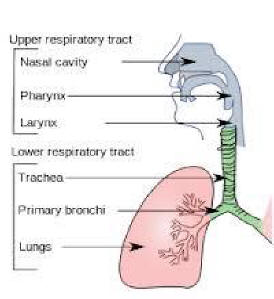
The respiratory system is composed of two sections, the upper and lower tracts, as illustrated above. The upper tract includes the nasal cavity. When breathing and swallowing become uncoordinated during the first stage of eating or drinking, food, and more commonly liquid, can be forced into the nasal cavity (and sometimes actually comes out of the nose). After food has been chewed and saliva mixed with it in the mouth, the back of the tongue elevates until it touches the roof of the mouth. The muscles at the back of the tongue form a trough through which the ball of food, or bolus, is forced, to project it into the esophagus. Before anything can be swallowed there are several changes that must happen at the back of the mouth and throat to allow a safe swallow.
The pharynx sits just above the larynx or vocal folds (commonly called vocal cords, but this name is not accurate). The pharynx divides into two tubes just above the vocal folds: the trachea (or windpipe), and the esophagus (the tube that carries food and liquid from the mouth to the stomach). A flap of cartilage (the epiglottis) is attached to the top of the larynx. When breathing is executed the epiglottis is relatively vertical or open. However, when a swallow is going to take place the epiglottis folds down over the opening to the vocal folds prohibiting material that is being swallowed from entering the trachea. When the epiglottis covers the vocal folds, respiration is stopped. During a swallow, no breathing takes place for the duration of the swallow. Most people inhale prior to swallowing and exhale after the swallow. It is believed that the process of exhaling after a swallow clears away any remaining particles from the trachea. However, some people exhale prior to the swallow and inhale after its completion, thus negating the hypothesis described above for those individuals.
Eating, drinking and breathing coordinate easily when the process just described functions well. When they do not synchronize properly, choking or pulmonary aspiration can occur. Choking occurs when something partially or completely blocks the passage of air from the environment into the lungs, getting stuck in the throat or windpipe. In most cases of choking, coughing will dislodge whatever is stuck in the throat. If coughing doesn’t work, abdominal thrusts, known as the Heimlich-Maneuver, has been recommended for many years. Today the American Red Cross and the American Heart Association have evolved into recommending a series of steps to alleviate choking sometimes referred to as 5 and 5:
1. Encourage coughing
2. Back slapping using the heal of the hand on the back of the person choking (repeat 5 times)
3. Abdominal compressions, i.e., Heimlich-Maneuver (repeat 5 times)
Once the person loses consciousness due to lack of oxygen caused by the obstruction in the windpipe, treatment should be changed to CPR (cardiopulmonary resuscitation) to try and provide oxygen to the unconscious person. Urgent medical help should be sought if the material that has caused the choking cannot be removed quickly. Choking quickly resolves or escalates to an emergency condition that can result in death.
Pulmonary aspiration can be similar to choking and its impact can range from none to death. Material can be inhaled into the trachea, bronchial tubes or lungs. The resulting impact depends upon what is aspirated, its size and the level it is inhaled into the pulmonary system. If pure water is inhaled in a small amount, it may have no impact. However, if something acidic is drawn into the pulmonary system, such as materials regurgitated from the stomach, containing stomach acid, the lining of the trachea, bronchial tubes or lungs could be damaged and become inflamed. Should bacteria be inhaled into the lungs (from the gut or respiratory system), bacterial pneumonia can result.
The average person is protected from aspiration by their body’s natural reactions – swallowing and coughing. For significant aspiration to occur these natural reactions must be suppressed due to an altered level of consciousness including unconsciousness. The presence of neurological disease or a head injury may cause a changed neurological state. An altered level of consciousness is seen in people who are drunk or have had a drug overdose, those in a comma or are under general anesthetic, and those suffering from dementia and other neurologically impacting diseases including strokes. Many disabling diseases, both congenital and acquired, can cause neurological damage resulting in altered cognitive function that may be permanent or temporary. This change in function can impact the ability to eat and drink safely.
For those who have chronic neurological disorders the texture and viscosity of the food and drink that they consume should be modified to accommodate their increased risk of aspiration. The intake of thickened liquids can reduce the likelihood of aspirating liquids. Those who suffer from some level of chronic pulmonary aspiration frequently have a “rattle” in their lungs when they breathe. For those who must consume thickened liquids to avoid aspiration, the Thickened Liquid Cup is available from Mealtime Partners. It controls the volume of the flow of thickened liquid as it is being drunk.
For those who are at risk of aspirating thin liquids, Mealtime Partners sells two other cups that may provide a safer method of drinking: the Provale Cup that dispenses 5-ccs of liquid for each drink taken from the cup; and the Rije Cup that dispenses an adjustable volume of liquids from 3-ccs to 15-ccs per sip.
Pulmonary aspiration is common in people who have eating and drinking disorders and, therefore, it is referred to in many of Mealtime Partners Newsletter articles. However, frequently the term is abbreviated to aspiration without any qualifying descriptor. In all cases when the term aspiration is used, it is referring to pulmonary aspiration. When other types of aspiration are being discussed you will find that the type of aspiration is qualified.
|
Mealtime Partners Slide-Track Mounting Products |
|
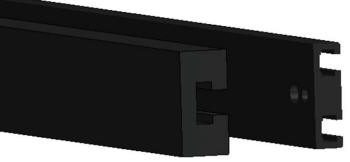
|
|
|
Many of the newer models of powered wheelchair have mounting
hardware built into them as an integral part of the chairs. The hardware takes the form of rectangular
rails that have slots in them that are commonly known as
T-slots (illustrated above). This hardware was intended by
the wheelchair manufacturers to allow them to mount chair
accessories, like the headrest, easily. However, they also
allow other items to be mounted on the wheelchair. Mealtime
Partners refers to these mounting rails as “slide-tracks”.
Depending upon the wheelchair manufacturer, the slide tracks
have a single slot or dual slots in them. Slide-tracks are
found in additional locations, like the back of the seat or
under the arm rests, not just the sides of the seat, on most
wheelchairs that utilize the slide-tracks. Wheelchairs with these slide-tracks often do not have any tubular components to attach the Mealtime Partners wheelchair mounting accessories. Because this is a relatively new way of mounting, Mealtime Partners has expanded its product line to accommodate attaching its drinking and mounting systems to slide-track mounts. Instead of two separate nuts, we use an elongated T-Nut with two screws for a more solid attachment and an attachment method that resists rotation. The differences between wheelchair manufacturers is the size of the T-slot, so we have different T-Nuts to accommodate the differences. Two examples of the Mealtime Partners drinking systems for track mounting are pictured below. |
|
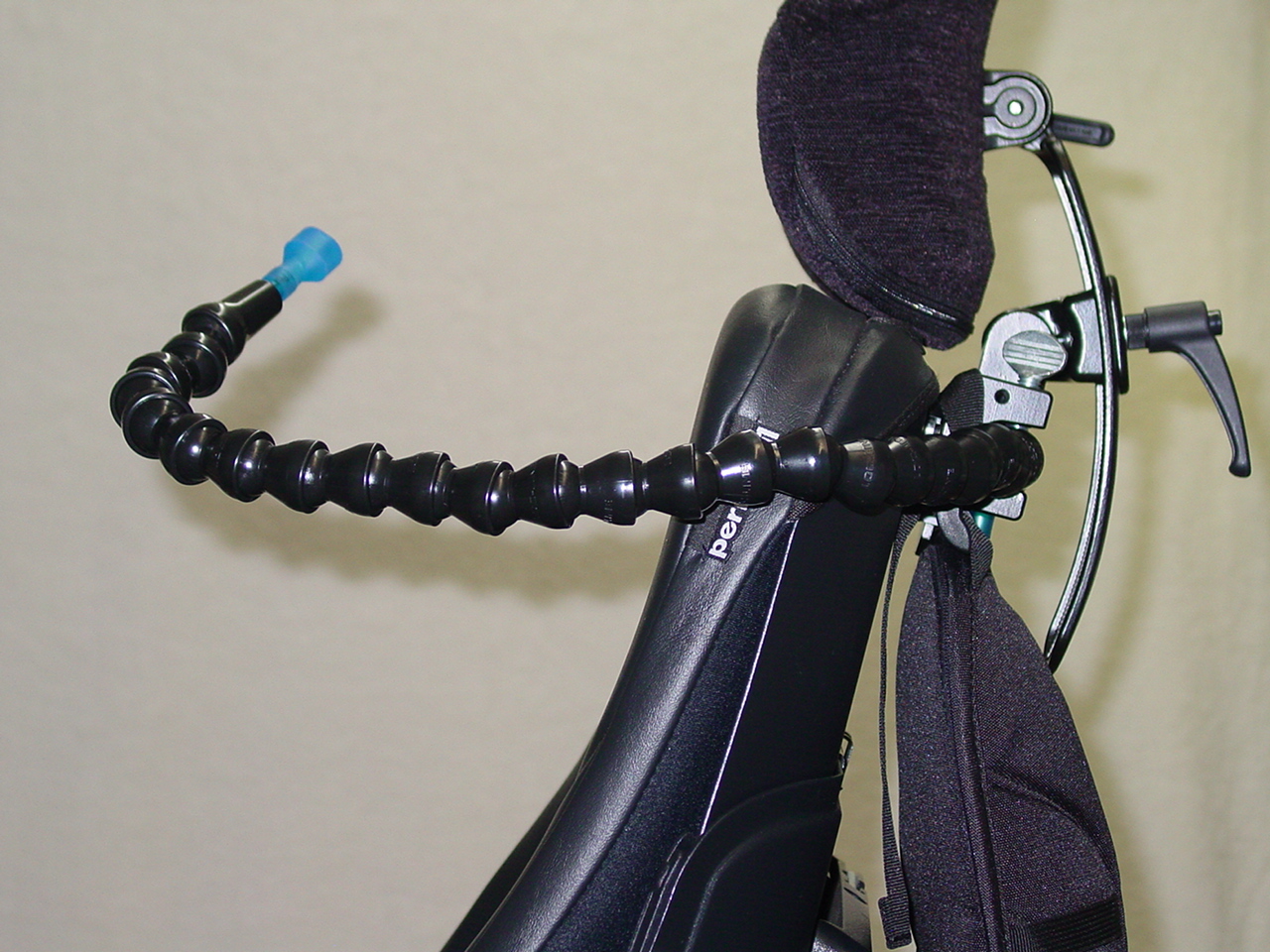
|
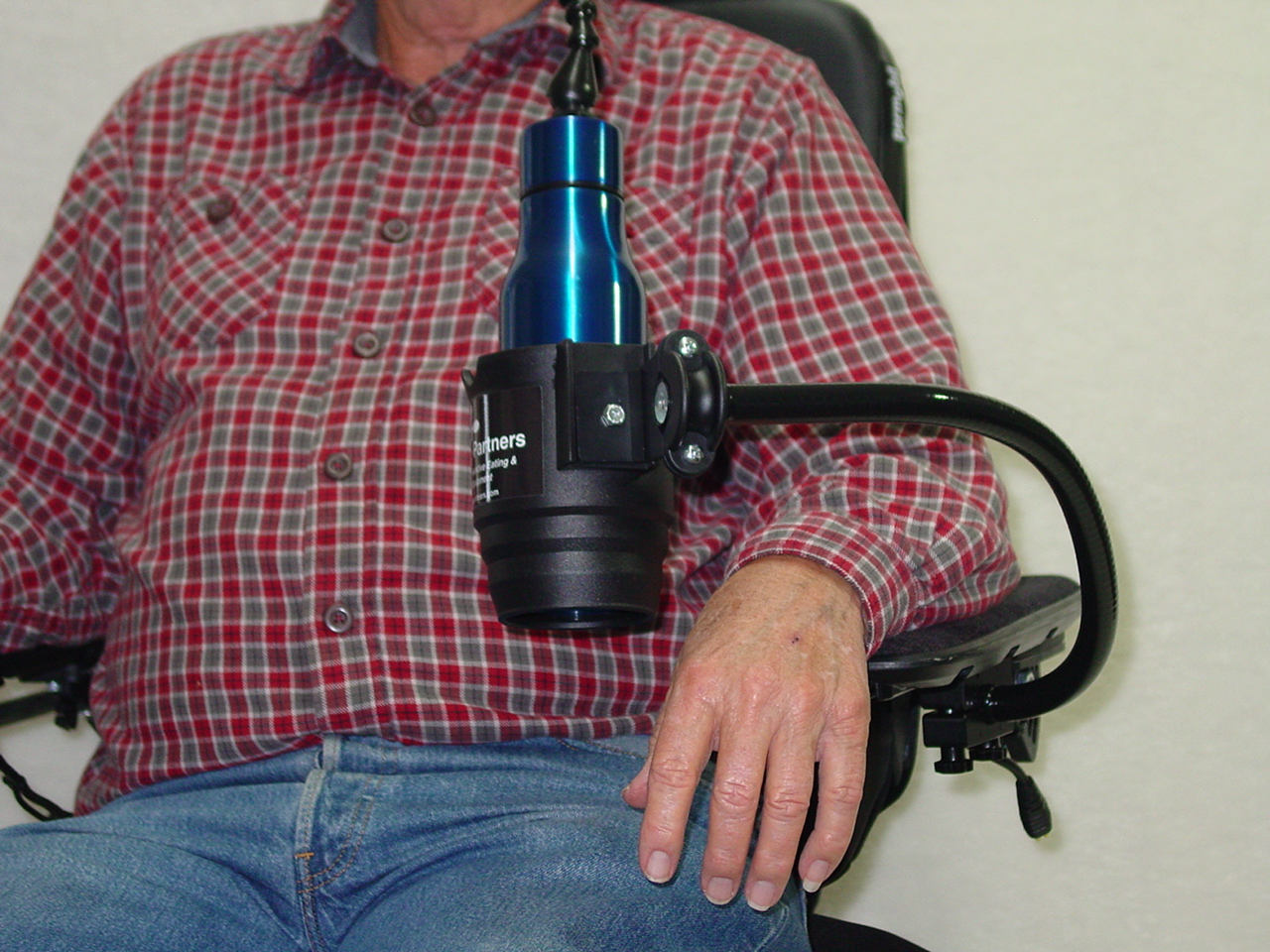
|
| Hydration Backpack with Drinking Tube Positioning for Slide-Track (6557) | The Mealtime Partners Front Mounted Drinking System for Slide-Track (5918) |
|
The mounting products for these two drinking
systems are pictured below. On the left, the Attachment
Holder for Slide-Track (Mealtime Partners part number 4673)
is used for the Hydration Backpack with Drinking Tube
Positioning for Slide-Track; and, on the right, the Flex Arm
Holder (part number 4970) secures the Front Mounted Drinking
System to the wheelchair track under the wheelchair armrest.
(If you purchase either of these drinking systems for
Slide-Track, it will come with the appropriate clamping
system.) T-nuts that attach the Attachment Holder and the Flex Arm Holder, shown below, are available in two sizes. The Permobil "unitrack" slots are slightly smaller than those used by the other manufacturers so the size of slot must be specified when ordering: 1 for UniTrack and 2 for Standard-Track. The smaller T-nut accommodates the UniTrack slide-tracks on Permobil wheelchairs while the larger T-nuts fit the standard slide-tracks used on other brands of wheelchairs. The original Mealtime Partners mounting systems are still available if you wish to clamp to a wheelchair that has a tubular frame like most manual wheelchairs. |
|
|
|
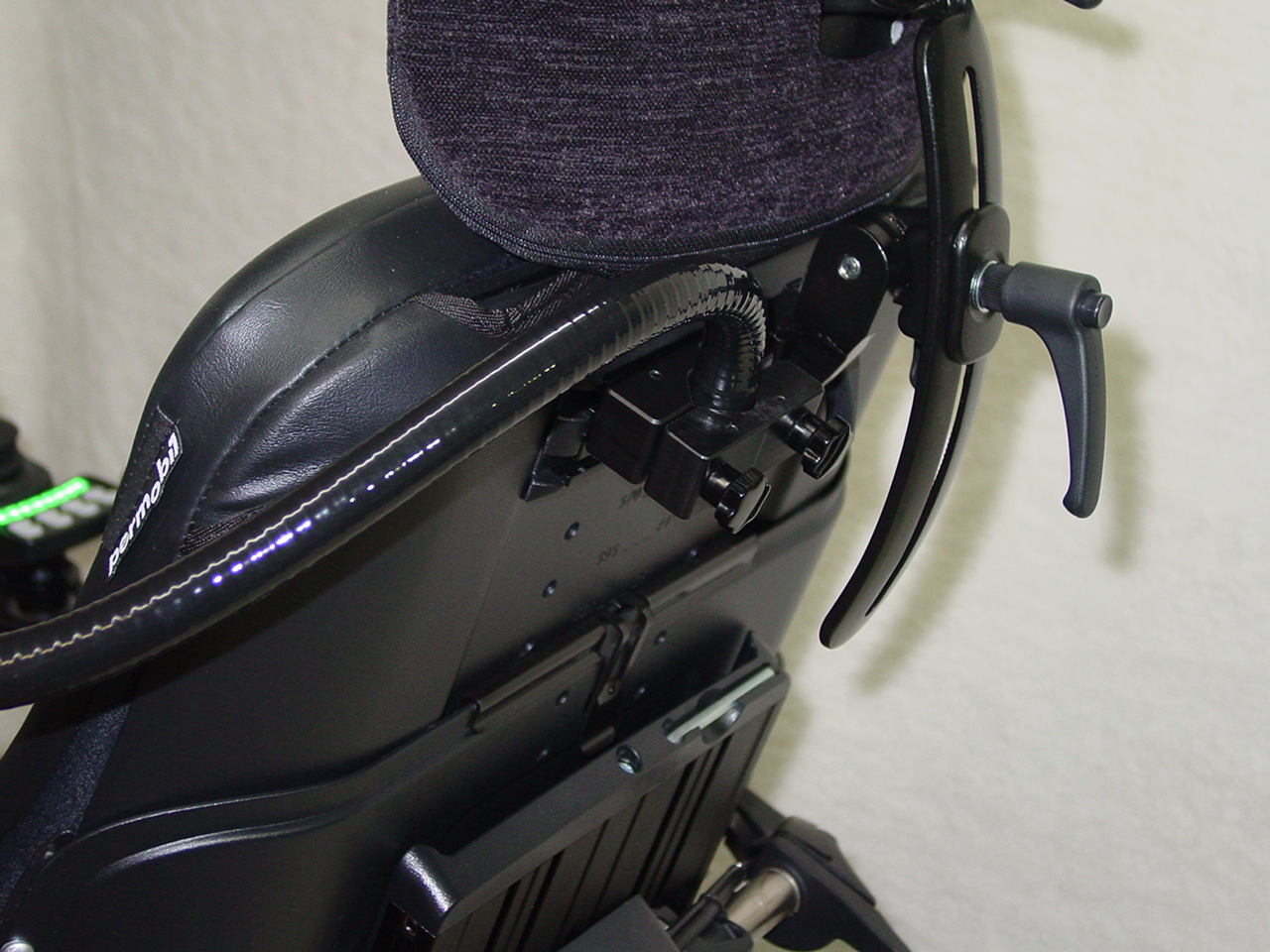
|
| Attachment Holder for Slide-Track (4973) | Flex Arm Holder for Slide-Track (4970) |
| Both of these examples are of Drinking Systems that can be mounted on wheelchairs with tracks because we believe good hydration is very important. However, Mealtime Partners also offers a selection of mounting systems for adaptive switches and other devices for slide-track. Information about these products can be found at Mealtime Partners website: Mounting Products for Slide-Tracks For additional information, call us at 800-996-8607, or email info@mealtimepartners.com. We will be pleased to help you with your product selections. | |
Changes to Mounting the Drink Partner on Slide-Track
Currently, Mealtime Partners sells two different mounting methods for our Drink Partner Drinking System. One provides a mounting system that attaches the cup holder to a manual wheelchair, or metal bed rail (part number 6040). The other attaches the cup holder to the slide-track on a powered wheelchair (part number 6050). When slide-track first started being used to mount parts on powered wheelchairs they were only found on the horizontal planes of the wheelchair, e.g., along the sides of the of the seat cushion, or under the arm rests, etc. Now, slide-tracks can be found both vertically and horizontally on many varieties of wheelchairs. With this evolution in the chair design comes the need for Drink Partner Drinking Systems to mount on rails oriented in either direction.
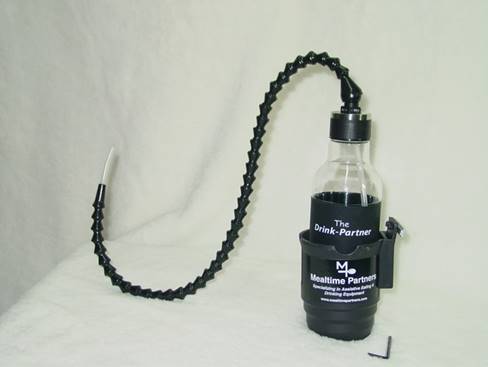 |
| Figure 1 - The Mealtime Partners Drink Partner Drinking System |
The Drink-Partner consists of a bottle and Cup Holder. The Cup Holder can be mounted to any of the slide-tracks that are on the wheelchair. The Cup Holder assembly has 3 components: the Cup Holder, the T-nut, and the extension bar, as shown in figure 2.
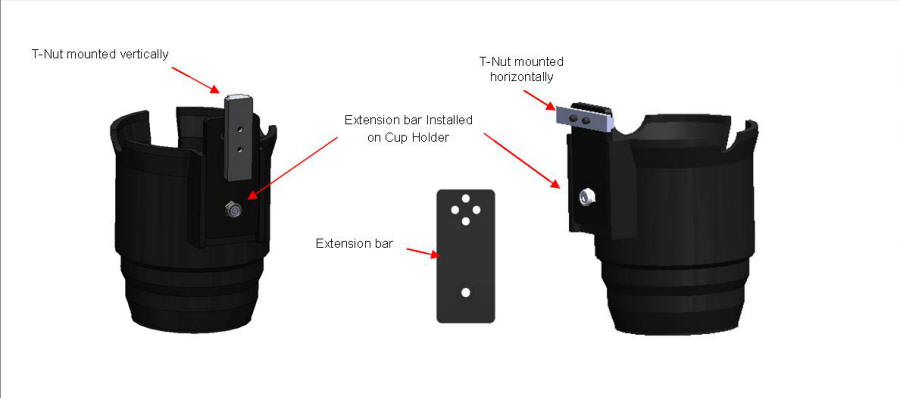 |
| Figure 2 -The Drink Partner Drink Holder Components |
The extension bar is used to mount the T-nut that is used to attach the cup holder to the slide-track. There are 4 holes in the top of the extension bar and the T-nut can be attached vertically or horizontally to the bar using two screws depending upon the orientation of the slide-track (as shown in Figure 3, below).
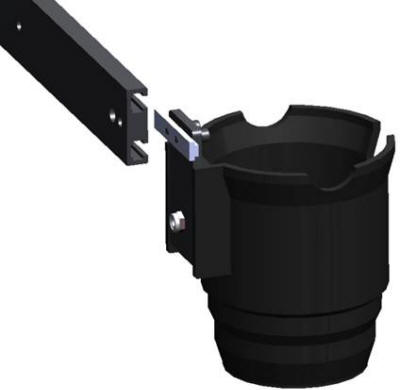 |
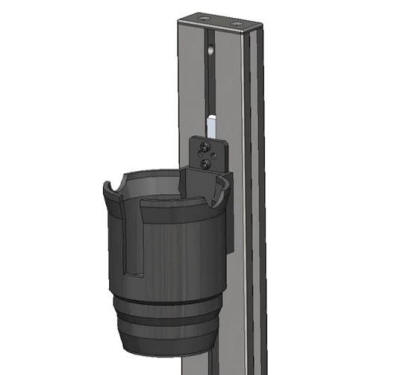 |
| Horizontal Slide-Track Mounting | Vertical Slide-Track Mounting |
| Figure 3 - Cup Holder Mounting | |
When ordering the Drink Partner Drinking System for Slide-Track you will need to specify the type of T-nut that will fit on your wheelchair. Mealtime Partners offers 2 different sizes of T-nuts. One is designed to fit into the UniTrack slide-rail which is manufactured by Permobil and has dual T-slots (or tracks). The other fits into the tracks on all other powered wheelchair. We call that size the Standard T-nut.
|
Did you know? Did you know that genetic testing is now available to match the best psychiatric drug for a specific individual’s disorder? Until now, if you needed psychiatric medications, finding the one that worked for you could be difficult. Typically a trial and error approach was used to identify the medication that actually works to help your disorder. Even though there is still skepticism among scientists in the field about the value of genetic testing, testing is becoming more commonly used to reduce the trial and error period for identifying the best pharmaceutical treatments for mental health disorders. UnitedHealthcare, the largest health care insurer in the United States, now covers the cost of these tests, and other insurance companies are also considering undertaking the cost. National Public Radio (NPR) reported on this topic and more information can be found by clicking here. |